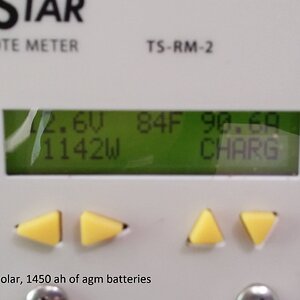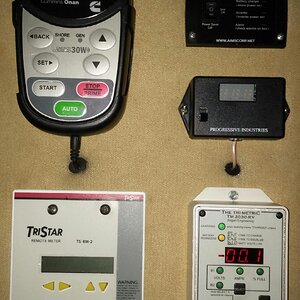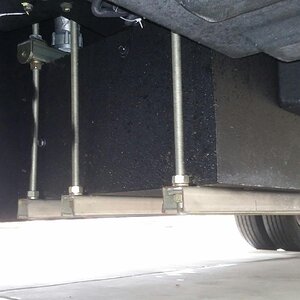You probably already found plenty or info here, but the short answer is do the math. Look at your charger output, amount of charge needed, and you can calulate the time needed. A good battery monitor system is essential for this.
I found this:
TM2030RV-Trimetric 2030RV Battery System Monitor , with the requisite shunt very helpful when I had a system like yours. Ask Randy at Best Converter and he’ll set you up and take good care of you.
And yes, these links are ok here. This is the kinder and genttler RV forum!

Also I agree - a few red LEDs are not sufficient if you want to optimize battery life. This is what the TriMetric does:
The TriMetric TM-2030 is our new battery monitor. It is a standalone monitor, but it can also work in tandem with our new
SC-2030 charge controller for optimized battery life, capacity use and efficiency. TriMetric TM-2030 is available in two models:TM-2030-RV and TM-2030-A. Our older models (TM-2025 and TM-2020) are still supported.
The TriMetric is used to monitor battery systems used in remote homes, RVs or boats that have batteries that store solar, wind, or possibly generator powered chargers. They will help you maintain your batteries.
All models are designed to monitor the following:
- “Percent Full” (“State of charge”) of your batteries, so you can see if you need to charge them more, or check that overall usage is less than your charging resources.
- Volts of the batteries, for example to check that they are being charged at proper voltage.
- Energy going in, or out of your batteries, measured in amps or watts, so you can see that your charging sources are charging properly, or how much current your loads are using.
- How many days since the batteries were fully charged: to remind you to not wait too long between fully charging your batteries to maximize their life.
The TM2030 is easier for you to program the necessary system parameters.
- The TM2030 has some minimal data logging, which can be useful for a technician to diagnose some common setup or operational problems with battery systems.
- The TM-2030 will operate with (nominal) battery systems from 12 to 48V. The TM-2020 will operate with 12 or 24 V systems, but requires the addition of the “TM-48VA” Adapter and lightning protection board when using it with 48V battery systems. This also provides lightning protection for the TM-2020.
- The TM-2030 can also monitor the voltage only of a second battery, such as a starting battery, or possibly also the input voltage of a solar array (if less than 100 volts.)
- The TM-2030 has a “simplified” level of operation suitable for most users, but can be configured for more flexibility (and complexity) where occasionally required.
- (For the technically knowledgeable only) The TM-2030 has a serial data output of all the “real time” data—which could be used to access data for other control or output in, for example OEM applications.
- The newer TM-2030 includes better lightning protection compared with the TM-2020.
- It is easier to view and enter programmed parameters..
- It is about typically about $15 more than the TM-2020. For 48V systems it is less expensive than the TM-2020 because it does not require an extra 48 volt adapter.












